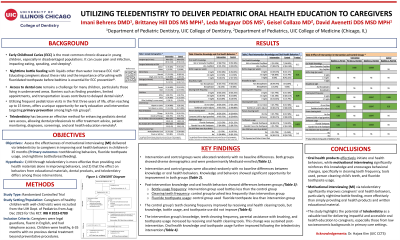Preventive
147 - Utilizing Teledentistry to Deliver Pediatric Oral Health Education to Caregivers


Imani J. Behrens, DMD (she/her/hers)
Pediatric Dentistry Resident, PGY-2
University of Illinois at Chicago, Chicago IL
University of Illinois Chicago
Chicago, Illinois, United States- GC
Geisel Collazo, MD, FAAP
University of Illinois Hospital & Health Sciences System
- BH
Brittaney Hill, DDS, MS, MPH
University of Illinois at Chicago, College of Dentistry
- LM
Leda Mugayar, DDS, MS
University of Illinois at Chicago, College of Dentistry
.jpg)
David M. Avenetti, DDS, MSD, MPH (he/him/his)
Associate Professor and Head, Department of Pediatric Dentistry
University of Illinois at Chicago, Chicago IL
University of Illinois Chicago, Dept. of Pediatric Dentistry
Chicago, Illinois, United States
Brittaney J. Hill, DDS, MS, MPH
Clinical Assistant Professor and Program Director, Department of Pediatric Dentistry
University of Illinois at Chicago
University of Illinois at Chicago
Chicago, Illinois, United States
Presenting Author(s)
Co-Author(s)
Research Mentor(s)
Program Director(s)
Purpose: This randomized controlled trial assessed the effect of motivational interviewing (MI) using teledentistry on nighttime oral health behaviors in children under three years old.
Methods: Sixty-four participants were recruited from a pediatric medical clinic between August-October 2023. Inclusion criteria were English-speaking caregivers of healthy children aged 6-35 months without prior dental treatment. Caregivers completed a baseline questionnaire then received oral hygiene products and a printed oral health education pamphlet during their child's primary care visit. After randomization, the intervention participants completed a 15-minute teledentistry session 30-45 days after enrollment. Both groups completed a follow-up questionnaire 60-75 days after enrollment, focusing on primary outcomes: toothbrushing/cleaning frequency, fluoride toothpaste usage, and bottle use. Descriptive and bivariate analyses were performed with statistical significance set at α < 0.05.
Results: Caregivers were 94% mothers, mean age 29.1 years (SD=5.6), 56% Black, 19% White, and 25% “Other” race with 36% identifying as Hispanic ethnicity. Children were 55% female, mean age 15.1 months (SD=7.5), and 81% Medicaid-enrolled. There were no baseline differences in intervention/control group demographics or oral health behaviors. Thirty-eight participants (N=19 control, N=19 intervention) were included in intention-to-treat analysis (41% loss to follow-up). Both the intervention (P=.008) and control (P=.017) groups showed improvement in toothbrushing/cleaning frequency. The intervention decreased nighttime bottle usage (P=.019) and increased fluoride toothpaste use (P=.005), whereas the verbal/written education “control” showed no significant effects.
Conclusion: While verbal/written educational materials can improve children's oral health behaviors, MI teledentistry interactions offer effective and accessible education to caregivers from low socioeconomic primary care settings.
Identify Supporting Agency and Grant Number:

.jpg)